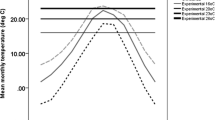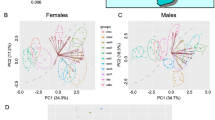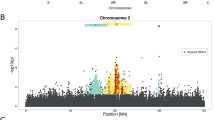Abstract
Drosophila melanogaster invaded Australia around 100 years ago, most likely through a northern invasion. The wide range of climatic conditions in eastern Australia across which D. melanogaster is now found provides an opportunity for researchers to identify traits and genes that are associated with climatic adaptation. Allozyme studies indicate clinal patterns for at least four loci including a strong linear cline in Adh and a non-linear cline in α-Gpdh. Inversion clines were initially established from cytological studies but have now been validated with larger sample sizes using molecular markers for breakpoints. Recent collections indicate that some genetic markers (Adh and In(3R)Payne) have changed over the last 20 years reflecting continuing evolution. Heritable clines have been established for quantitative traits including wing length/area, thorax length and cold and heat resistance. A cline in egg size independent of body size and a weak cline in competitive ability have also been established. Postulated clinal patterns for resistance to desiccation and starvation have not been supported by extensive sampling. Experiments under laboratory and semi-natural conditions have suggested selective factors generating clinal patterns, particularly for reproductive patterns over winter. Attempts are being made to link clinal variation in traits to specific genes using QTL analysis and the candidate locus approach, and to identify the genetic architecture of trait variation along the cline. This is proving difficult because of inversion polymorphisms that generate disequilibrium among genes. Substantial gaps still remain in linking clines to field selection and understanding the genetic and physiological basis of the adaptive shifts. However D. melanogaster populations in eastern Australia remain an excellent resource for understanding past and future evolutionary responses to climate change.



Similar content being viewed by others
References
Agis M, Schlötterer C (2001) Microsatellite variation in natural Drosophila melanogaster populations from New South Wales (Australia) and Tasmania. Mol Ecol 10:1197–1205
Anderson AR, Collinge JE, Hoffmann AA, Kellett M, McKechnie SW (2003) Thermal tolerance tradeoffs associated with the right arm of chromosome 3 and marked by the Hsr-omega gene in Drosophila melanogaster. Heredity 90:195–202
Anderson AR, Hoffmann AA, McKechnie SW, Umina PA, Weeks AR (2005) The latitudinal cline in the In(3R)Payne inversion polymorphism has shifted in the last 20 years in Australian Drosophila melanogaster populations. Mol Ecol 14:851–858
Anderson PR, Knibb WR, Oakeshott JG (1987) Observations on the extent and temporal stability of latitudinal clines for alcohol dehydrogenase allozymes and 4 chromosome inversions in Drosophila melanogaster. Genetica 75:81–88
Andolfatto P, Kreitman M (2000) Molecular variation at the In(2L)t proximal breakpoint site in natural populations of Drosophila melanogaster and D. simulans. Genetics 154:1681–1691
Azevedo RBR, French V, Partridge L (1996) Thermal evolution of egg size in Drosophila melanogaster. Evolution 50:2338–2345
Azevedo RBR, James AC, McCabe J, Partridge L (1998) Latitudinal variation of wing/thorax size ratio and wing-aspect ratio in Drosophila melanogaster. Evolution 52:1353–1362
Balanya J, Serra L, Gilchrist GW, Huey RB, Pascual M, Mestres F, Sole E (2003) Evolutionary pace of chromosomal polymorphism in colonizing populations of Drosophila subobscura: an evolutionary time series. Evolution 57:1837–1845
Baudry E, Viginier B, Veuille M (2004) Non-African populations of Drosophila melanogaster have a unique origin. Mol Biol Evol 21:1482–1491
Bettencourt BR, Kim I-Y, Hoffmann AA, Feder ME (2002) Response to natural and laboratory selection at the Drosophila HSP70 genes. Evolution 56:1796–1801
Bochdanovits Z, van der Klis H, de Jong G (2003) Covariation of larval gene expression and adult body size in natural populations of Drosophila melanogaster. Mol Biol Evol 20:1760–1766
Bock IR, Parsons PA (1981) Species of Australia and New Zealand. In: Ashburner M, Carson HL, Thompson JN (eds) Genetics and biology of Drosophila, vol 3a. Academic Press, London, pp 291–308
Boussy IA (1987) A latitudinal cline in P-M gonadal dysgenesis potential in Australian Drosophila melanogaster populations. Genet Res 49:11–18
Boussy IA, Healy MJ, Oakeshott JG, Kidwell MG (1988) Molecular analysis of the P-M gonadal-dysgenesis cline in eastern Australian Drosophila melanogaster. Genetics 119:889–902
Boussy IA, Itoh M, Rand D, Woodruff RC (1998) Origin and decay of the P element-associated latitudinal cline in Australian Drosophila melanogaster. Genetica 104:45–57
Boussy IA, Kidwell MG (1987) The P-M hybrid dysgenesis cline in eastern Australian Drosophila melanogaster: discrete P, Q and M regions are nearly contiguous. Genetics 115:737–745
Bradshaw WE, Holzapfel CM (2001) Genetic shift in photoperiodic response correlated with global warming. Proc Natl Acad Sci USA 98:14509–14511
Bregliano JC, Kidwell MG (1983) Hybrid dysgenesis determinants. In: Shapiro J (ed) Mobile genetic elements. Academic Press, New York, pp 363–409
Bubli OA, Rakitskaya TA, Imasheva AG (1996) Variation of allozyme loci in populations of Drosophila melanogaster from the former USSR. Heredity 77:638–645
Calboli FCF, Kennington WJ, Partridge L (2003) QTL mapping reveals a striking coincidence in the positions of genomic regions associated with adaptive variation in body size in parallel clines of Drosophila melanogaster on different continents. Evolution 57:2653–2658
Castiglione-Morelli MA, Guantieri V, Villani V, Kyriacou CP, Costa R, Tamburro AM (1995) Conformational study of the Thr-Gly repeat in the Drosophila clock protein, PERIOD. Proc R Soc Lond B 260:155–163
Collinge JE, Hoffmann AA, McKechnie SW (2006) Altitudinal patterns for latitudinally-varying traits and polymorphic markers in Drosophila melanogaster from eastern Australia. J Evol Biol 19:473–482
Costa R, Peixoto AA, Barbujani G, Kyriacou CP (1992) A latitudinal cline in a Drosophila clock gene. Proc R Soc Lond B 250:43–49
Dahlgaard J, Hasson E, Loeschcke V (2001) Behavioural differentiation in oviposition activity in Drosophila buzzatii from highland and lowland populations in Argentina: plasticity or thermal adaptation? Evolution 55:738–747
Davidson JK (1990) Non-parallel geographic patterns for tolerance to cold and desiccation in Drosophila melanogaster and D. simulans. Aust J Zool 38:155–161
Dobzhansky T (1970) Genetics of the evolutionary process. Columbia University Press, New York
Endler JA (1977) Geographic variation, speciation, and clines. Princeton University Press, Princeton, NJ
Endler JA (1986) Natural selection in the wild. Princeton University Press, Princeton
Etges WJ (1989) Chromosomal influences on life-history variation along an altitudinal transect in Drosophila robusta. Am Nat 133:83–110
Etges WJ, Levitan M (2004) Palaeoclimatic variation, adaptation and biogeography of inversion polymorphisms in natural populations of Drosophila robusta. Biol J Linn Soc 81:395–411
Fry AJ, Palmer MR, Rand DM (2004) Variable fitness effects of Wolbachia infection in Drosophila melanogaster. Heredity 93:379–389
Frydenberg J, Hoffmann AA, Loeschcke V (2003) DNA sequence variation and latitudinal associations in hsp23, hsp26 and hsp27 from natural populations of Drosophila melanogaster. Mol Ecol 12:2025–2032
Gilchrist GW, Partridge L (2001) Contrasting genetic architecture of wing size and shape. Heredity 86:144–152
Gockel J, Kennington WJ, Hoffmann A, Goldstein DB, Partridge L (2001) Nonclinality of molecular variation implicates selection in maintaining a morphological cline of Drosophila melanogaster. Genetics 158:319–323
Gockel J, Robinson SJ, Kennington WJ, Goldstein DB, Partridge L (2002) Quantitative genetic analysis of natural variation in body size in Drosophila melanogaster. Heredity 89:145–153
Griffiths JA, Schiffer M, Hoffmann AA (2004) Clinal variation and laboratory adaptation in the rainforest species Drosophila birchii for stress resistance, wing size and wing shape and development time. J Evol Biol 18:213–222
Hercus MJ, Hoffmann AA (2000) Maternal and grandmaternal age influence offspring fitness in Drosophila. Proc R Soc Lond B 267:2105–2110
Hoffmann AA (1988) Partial cytoplasmic incompatibility between two Australian populations of Drosophila melanogaster. Entomol Exp Appl 48:61–67
Hoffmann AA, Anderson A, Hallas R (2002) Opposing clines for high and low temperature resistance in Drosophila melanogaster. Ecol Lett 5:614–618
Hoffmann AA, Clancy DJ, Merton E (1994) Cytoplasmic incompatibility in Australian populations of Drosophila melanogaster. Genetics 136:993–999
Hoffmann AA, Hallas R, Deans J, Schiffer M (2003a) Low potential for climatic stress adaptation in a rainforest Drosophila species. Science 301:100–102
Hoffmann AA, Hallas R, Sinclair C, Mitrovski P (2001) Levels of variation in stress resistance in Drosophila among strains, local populations, and geographic regions: patterns for desiccation, starvation, cold resistance, and associated traits. Evolution 55:1621–1630
Hoffmann AA, Hercus M, Dagher H (1998) Population dynamics of the Wolbachia infection causing cytoplasmic incompatibility in Drosophila melanogaster. Genetics 148:221–231
Hoffmann AA, Scott M, Partridge L, Hallas R (2003b) Overwintering in Drosophila melanogaster: outdoor field cage experiments on clinal and laboratory selected populations help to elucidate traits under selection. J Evol Biol 16:614–623
Hoffmann AA, Sgrò C, Weeks AR (2004) Chromosomal inversion polymorphisms and adaptation. Trends Ecol Evol 19:482–488
Hoffmann AA, Sorensen JG, Loeschcke V (2003c) Adaptation of Drosophila to temperature extremes: bringing together quantitative and molecular approaches. J Thermal Biol 28:175–216
Hoffmann AA, Watson M (1993) Geographical variation in the acclimation responses of Drosophila to temperature extremes. Am Nat 142:s93–s113
Huey RB, Gilchrist GW, Carlson ML, Berrigan D, Serra L (2000) Rapid evolution of a geographic cline in size in an introduced fly. Science 287:308–309
Inoue Y, Watanabe T, Watanabe TK (1994) Evolutionary change of the chromosomal polymorphism in Drosophila melanogaster populations. Evolution 38:753–765
Itoh M, Woodruff RC, Leone MA, Boussy IA (1999) Genomic P elements and P-M characteristics of eastern Australian populations of Drosophila melanogaster. Genetica 106:231–245
James AC, Azevedo RB, Partridge L (1997) Genetic and environmental responses to temperature of Drosophila melanogaster from a latitudinal cline. Genetics 146:881–890
James AC, Partridge L (1995) Thermal evolution of the rate of larval development in Drosophila melanogaster in lab and field populations. J Evol Biol 8:315–330
James AC, Azevedo RB, Partridge L (1995) Cellular basis and developmental timing in a size cline of Drosophila melanogaster. Genetics 140:659–666
Kamping A, Van Delden W (1999) The role of fertility restoration in the maintenance of the inversion In(2L)t polymorphism in Drosophila melanogaster. Heredity 83:460–468
Karan D, Dahiya N, Munjal AK, Gibert P, Moreteau B, Parkash R, David JR (1998) Desiccation and starvation tolerance of adult Drosophila—opposite latitudinal clines in natural populations of three different species. Evolution 52:825–831
Kennington WJ, Gockel J, Partridge L (2003) Testing for asymmetrical gene flow in a Drosophila melanogaster body-size cline. Genetics 165:667–673
Kennington WJ, Partridge L, Hoffmann AA (2006) Patterns of diversity and linkage disequilibrium within the cosmopolitan inversion In(3R)Payne in Drosophila melanogaster are indicative of coadaptation. Genetics 172:1655–1663
Kidwell MG, Kidwell JF, Sved JA (1977) Hybrid dysgenesis in Drosophila melanogaster: a syndrome of aberrant traits including mutation, sterility and male recombination. Genetics 86:813–833
Knibb WR (1983) Chromosome inversion polymorphisms in Drosophila melanogaster: 3. Gametic disequilibria and the contributions of inversion clines to the Adh and α-Gpdh clines in Australasia. Genetica 61:139–146
Knibb WR (1986) Temporal variation of Drosophila melanogaster Adh allele frequencies, inversion frequencies, and population sizes. Genetica 71:175–190
Knibb WR, Oakeshott JG, Gibson JB (1981) Chromosome inversion polymorphisms in Drosophila melanogaster. II. Geographic clines and climatic associations in Australasia, North America and Asia. Genetica 58:213–221
Knibb WR, Oakeshott JG, Gibson JB (1982) Chromosome inversion polymorphisms in Drosophila melanogaster. II. Geographic clines and climatic associations in Australasia, North America and Asia. Genetica 58:213–221
Kreitman M (1983) Nucleotide polymorphism at the alcohol dehydrogenase locus of Drosophila melanogaster. Nature 304:412–417
Krimbas CB, Powell JR (1992) Drosophila Inversion Polymorphism. CRC Press, Boca Raton
Magiafoglou A, Carew ME, Hoffmann AA (2002) Shifting clinal patterns and microsatellite variation in Drosophila serrata populations: a comparison of populations near the southern border of the species range. J Evol Biol 15:763–774
McColl G, Hoffmann AA, McKechnie SW (1996) Response of two heat shock genes to selection for knockdown heat resistance in Drosophila melanogaster. Genetics 143:1615–1627
McColl G, McKechnie SW (1999) The Drosophila heat shock hsr-omega gene: an allele frequency cline detected by quantitative PCR. Mol Biol Evol 16:1568–1574
McKechnie SW, Halford MM, McColl G, Hoffmann AA (1998) Both allelic variation and expression of nuclear and cytoplasmic transcripts of hsr-omega are closely associated with thermal phenotype in Drosophila. Proc Natl Acad Sci USA 95:2423–2428
McKenzie JA, McKechnie SW (1983) The alcohol dehydrogenase polymorphism in a vineyard cellar population of Drosophila melanogaster. In: Gibson JB, Oakeshott JG (eds) Genetic studies of Drosophila populations. ANU Press, Canberra
Mettler JA, Voelker AA, Mukai T (1977) Inversion clines in populations of Drosophila melanogaster. Genetics 87:169–176
Mitrovski P, Hoffmann AA (2001) Postponed reproduction as an adaptation to winter conditions in Drosophila melanogaster: evidence for clinal variation under semi-natural conditions. Proc R Soc Lond B 268:1–6
Norry FM, Dahlgaard J, LoeschckeV (2004) Quantitative trait loci affecting knockdown resistance to high temperature in Drosophila melanogaster. Mol Ecol 13:3585–3594
Oakeshott JG, Chambers GK, Gibson JB, Eanes WF, Willcocks DA (1983a) Geographic variation in G6pd and Pgd allele frequencies in Drosophila melanogaster. Heredity 50:67–72
Oakeshott JG, Chambers GK, Gibson JB, Willcocks DA (1981) Latitudinal relationships of esterase-6 and phosphoglucomutase gene frequencies in Drosophila melanogaster. Heredity 47:385–396
Oakeshott JG, Gibson JB, Anderson PR, Knibb WR, Anderson DG, Chambers GK (1982) Alcohol dehydrogenase and glycerol-3-phosphate dehydrogenase clines in Drosophila melanogaster on different continents. Evolution 39:86–96
Oakeshott JG, Gibson JB, Willcocks DA, Chambers GK (1983b) Latitudinal variation in octanol dehydrogenase and acid phosphatase allele frequencies in Drosophila melanogaster. Theoret Appl Genet 65:191–196
Oakeshott JG, McKechnie SW, Chambers GK (1984) Population genetics of the metabolically related Adh, Gpdh and Tpi polymorphisms in Drosophila melanogaster I. Geographic variation in Gpdh and Tpi allele frequencies on different continents. Genetica 63:21–29
Parsons PA (1977) Resistance to cold temperature stress in populations of Drosophila melanogaster and D. simulans. Aust J Zool 25:693–698
Perrot-Minnot MJ, Guo LR, Werren JH (1996) Single and double infections with Wolbachia in the parasitic wasp Nasonia vitripennis: effects on compatibility. Genetics 143:961–972
Prout T, Barker JSF (1993) F-Statistics in Drosophila buzzatii—selection, population size and inbreeding. Genetics 134:369–375
Rako L, Stocker AJ, Anderson AR, Sgrò CM, Hoffmann AA (2006) The association between inversion In(3R)Payne and clinally varying traits in Drosophila melanogaster. Genetica (in press)
Reynolds KT, Hoffmann AA (2002) Male age, host effects and the weak expression or non-expression of cytoplasmic incompatibility in Drosophila strains infected by maternally transmitted Wolbachia. Genet Res 80:79–87
Rodriguez-Trelles F, Rodriguez M (1998) Rapid micro-evolution and loss of chromosomal diversity in Drosophila in response to climate warming. Evol Ecol 12:829–838
Sawyer LA, Hennessy JM, Peixoto AA, Rosato E, Parkinson H, Costa R, Kyriacou CP (1997) Natural variation in a Drosophila clock gene and temperature compensation. Science 278:2117–2120
Sgrò C, Hoffmann AA (1998) Effects of temperature extremes on genetic variances for life history traits in Drosophila melanogaster as determined from parent-offspring comparisons. J Evol Biol 11:1–20
Singh BN, Das A (1992) Changes of inversion polymorphism in laboratory populations of Drosophila melanogaster. Zool Syst Evol 30:268–280
Stalker HD (1980) Chromosome studies in wild populations of Drosophila melanogaster: 2. Relationship of inversion frequencies to latitude, season, wing-loading and flight activity. Genetics 95:211–224
Stanley SM, Parsons PA (1981) The response of the cosmopolitan species, Drosophila melanogaster, to ecological gradients. Proc Ecol Soc Aust 11:121–130
Stouthamer R, Breeuwer JAJ, Hurst GDD (1999) Wolbachia pipientis: microbial manipulator of arthropod reproduction. Ann Rev Microbiol 53:71–102
Umina PA, Weeks AR, Kearney MR, McKechnie SW, Hoffmann AA (2005) A rapid shift in a classic clinal pattern in Drosophila reflecting climate change. Science 308:691–693
Umina PA, Hoffmann AA, Weeks AR, McKechnie SW (2006) An independent non-linear latitudinal cline for the sn-glycerol-3-phosphate (α-Gpdh) polymorphism of Drosophila melanogaster from eastern Australia. Genet Res (in press)
Van ‘t Land J, Van PWF, Villarroel H, Kamping A, Van DW (2000) Latitudinal variation for two enzyme loci and an inversion polymorphism in Drosophila melanogaster from Central and South America. Evolution 54:201–209
Weeks A, McKechnie SW, Hoffmann AA (2002) Dissecting adaptive clinal variation: markers, inversions and size/stress associations in Drosophila melanogaster from a central field population. Ecol Lett 5:756–763
Weeks A, McKechnie SW, Hoffmann AA (2006) In search of clinal variation in the period and clock timing genes in Australian Drosophila melanogaster populations. J Evol Biol 19:551–557
Wesley CS, Eanes WF (1994) Isolation and analysis of the breakpoint sequences of chromosome inversion In(3L)Payne in Drosophila melanogaster. Proc Natl Acad Sci USA 91:3132–3136
Worthen WB (1996) Latitudinal variation in developmental time and mass in Drosophila melanogaster. Evolution 50:2523–2529
Zilman JW (2003) Year book Australia. Australian Bureau of Statistics, Canberra
Acknowledgements
We thank George Gilchrist and Carol Eunmi Lee for the opportunity to present this overview, and the Australian Research Council via their Special Research Centre, Federation Fellowship and Postdoctoral Fellowship schemes for financial support.
Author information
Authors and Affiliations
Corresponding author
Rights and permissions
About this article
Cite this article
Hoffmann, A., Weeks, A. Climatic selection on genes and traits after a 100 year-old invasion: a critical look at the temperate-tropical clines in Drosophila melanogaster from eastern Australia. Genetica 129, 133–147 (2007). https://doi.org/10.1007/s10709-006-9010-z
Received:
Accepted:
Published:
Issue Date:
DOI: https://doi.org/10.1007/s10709-006-9010-z




